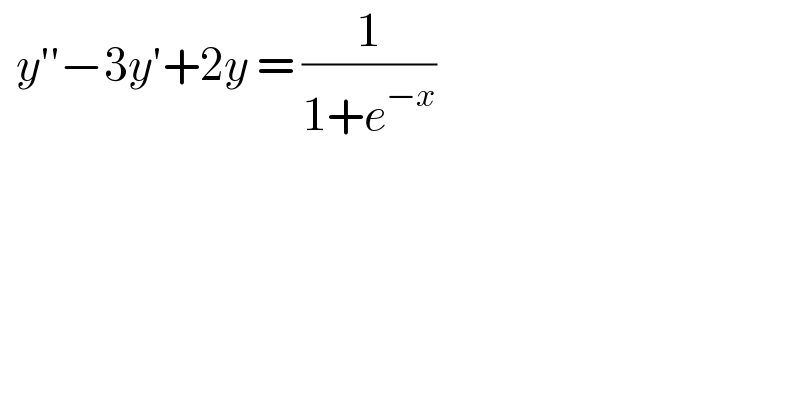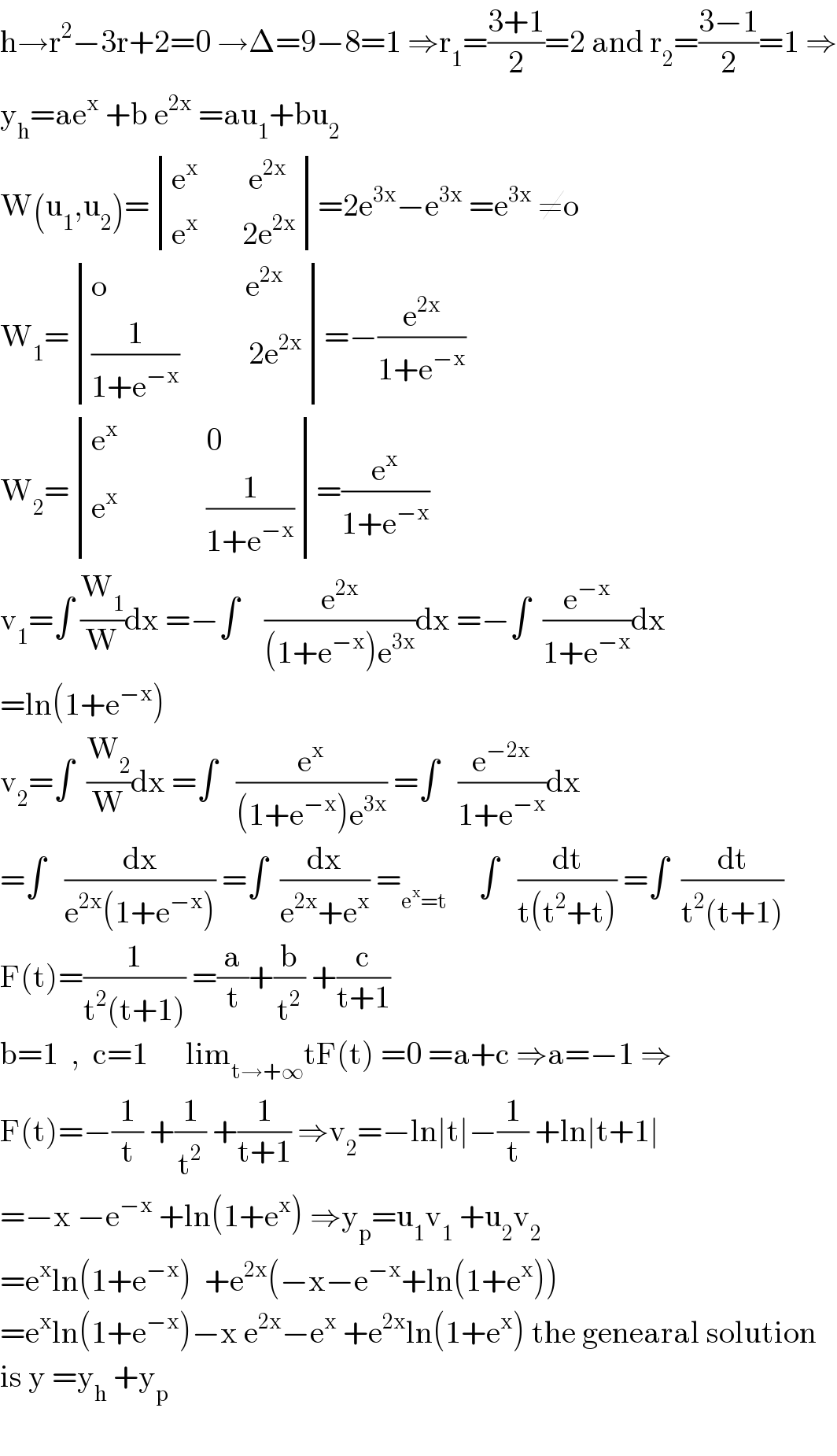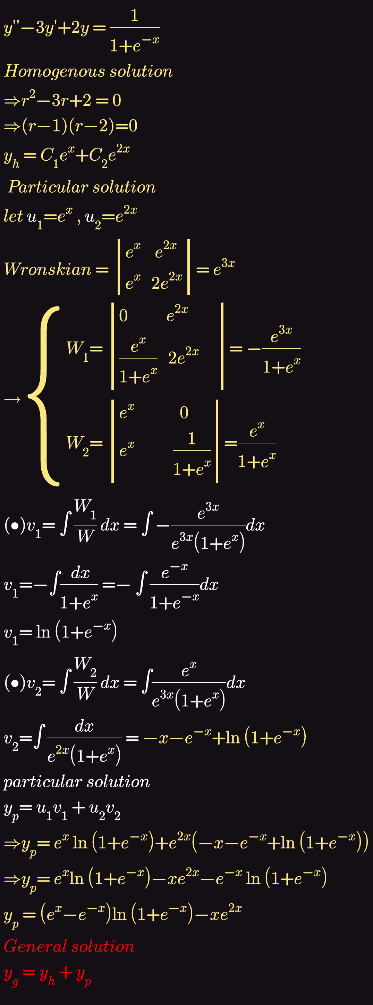Question Number 118274 by bobhans last updated on 16/Oct/20

$$\:\:{y}''−\mathrm{3}{y}'+\mathrm{2}{y}\:=\:\frac{\mathrm{1}}{\mathrm{1}+{e}^{−{x}} }\: \\ $$
Answered by mathmax by abdo last updated on 16/Oct/20

$$\mathrm{h}\rightarrow\mathrm{r}^{\mathrm{2}} −\mathrm{3r}+\mathrm{2}=\mathrm{0}\:\rightarrow\Delta=\mathrm{9}−\mathrm{8}=\mathrm{1}\:\Rightarrow\mathrm{r}_{\mathrm{1}} =\frac{\mathrm{3}+\mathrm{1}}{\mathrm{2}}=\mathrm{2}\:\mathrm{and}\:\mathrm{r}_{\mathrm{2}} =\frac{\mathrm{3}−\mathrm{1}}{\mathrm{2}}=\mathrm{1}\:\Rightarrow \\ $$$$\mathrm{y}_{\mathrm{h}} =\mathrm{ae}^{\mathrm{x}} \:+\mathrm{b}\:\mathrm{e}^{\mathrm{2x}} \:=\mathrm{au}_{\mathrm{1}} +\mathrm{bu}_{\mathrm{2}} \\ $$$$\mathrm{W}\left(\mathrm{u}_{\mathrm{1}} ,\mathrm{u}_{\mathrm{2}} \right)=\begin{vmatrix}{\mathrm{e}^{\mathrm{x}} \:\:\:\:\:\:\:\:\mathrm{e}^{\mathrm{2x}} }\\{\mathrm{e}^{\mathrm{x}} \:\:\:\:\:\:\:\mathrm{2e}^{\mathrm{2x}} }\end{vmatrix}=\mathrm{2e}^{\mathrm{3x}} −\mathrm{e}^{\mathrm{3x}} \:=\mathrm{e}^{\mathrm{3x}} \:\neq\mathrm{o} \\ $$$$\mathrm{W}_{\mathrm{1}} =\begin{vmatrix}{\mathrm{o}\:\:\:\:\:\:\:\:\:\:\:\:\:\:\:\:\:\:\:\:\:\:\mathrm{e}^{\mathrm{2x}} }\\{\frac{\mathrm{1}}{\mathrm{1}+\mathrm{e}^{−\mathrm{x}} }\:\:\:\:\:\:\:\:\:\:\:\mathrm{2e}^{\mathrm{2x}} }\end{vmatrix}=−\frac{\mathrm{e}^{\mathrm{2x}} }{\mathrm{1}+\mathrm{e}^{−\mathrm{x}} } \\ $$$$\mathrm{W}_{\mathrm{2}} =\begin{vmatrix}{\mathrm{e}^{\mathrm{x}} \:\:\:\:\:\:\:\:\:\:\:\:\:\:\mathrm{0}}\\{\mathrm{e}^{\mathrm{x}} \:\:\:\:\:\:\:\:\:\:\:\:\:\:\frac{\mathrm{1}}{\mathrm{1}+\mathrm{e}^{−\mathrm{x}} }}\end{vmatrix}=\frac{\mathrm{e}^{\mathrm{x}} }{\mathrm{1}+\mathrm{e}^{−\mathrm{x}} } \\ $$$$\mathrm{v}_{\mathrm{1}} =\int\:\frac{\mathrm{W}_{\mathrm{1}} }{\mathrm{W}}\mathrm{dx}\:=−\int\:\:\:\:\frac{\mathrm{e}^{\mathrm{2x}} }{\left(\mathrm{1}+\mathrm{e}^{−\mathrm{x}} \right)\mathrm{e}^{\mathrm{3x}} }\mathrm{dx}\:=−\int\:\:\frac{\mathrm{e}^{−\mathrm{x}} }{\mathrm{1}+\mathrm{e}^{−\mathrm{x}} }\mathrm{dx} \\ $$$$=\mathrm{ln}\left(\mathrm{1}+\mathrm{e}^{−\mathrm{x}} \right) \\ $$$$\mathrm{v}_{\mathrm{2}} =\int\:\:\frac{\mathrm{W}_{\mathrm{2}} }{\mathrm{W}}\mathrm{dx}\:=\int\:\:\:\frac{\mathrm{e}^{\mathrm{x}} }{\left(\mathrm{1}+\mathrm{e}^{−\mathrm{x}} \right)\mathrm{e}^{\mathrm{3x}} }\:=\int\:\:\:\frac{\mathrm{e}^{−\mathrm{2x}} }{\mathrm{1}+\mathrm{e}^{−\mathrm{x}} }\mathrm{dx} \\ $$$$=\int\:\:\:\frac{\mathrm{dx}}{\mathrm{e}^{\mathrm{2x}} \left(\mathrm{1}+\mathrm{e}^{−\mathrm{x}} \right)}\:=\int\:\:\frac{\mathrm{dx}}{\mathrm{e}^{\mathrm{2x}} +\mathrm{e}^{\mathrm{x}} }\:=_{\mathrm{e}^{\mathrm{x}} =\mathrm{t}} \:\:\:\:\:\int\:\:\:\frac{\mathrm{dt}}{\mathrm{t}\left(\mathrm{t}^{\mathrm{2}} +\mathrm{t}\right)}\:=\int\:\:\frac{\mathrm{dt}}{\mathrm{t}^{\mathrm{2}} \left(\mathrm{t}+\mathrm{1}\right)} \\ $$$$\mathrm{F}\left(\mathrm{t}\right)=\frac{\mathrm{1}}{\mathrm{t}^{\mathrm{2}} \left(\mathrm{t}+\mathrm{1}\right)}\:=\frac{\mathrm{a}}{\mathrm{t}}+\frac{\mathrm{b}}{\mathrm{t}^{\mathrm{2}} }\:+\frac{\mathrm{c}}{\mathrm{t}+\mathrm{1}} \\ $$$$\mathrm{b}=\mathrm{1}\:\:,\:\:\mathrm{c}=\mathrm{1}\:\:\:\:\:\:\mathrm{lim}_{\mathrm{t}\rightarrow+\infty} \mathrm{tF}\left(\mathrm{t}\right)\:=\mathrm{0}\:=\mathrm{a}+\mathrm{c}\:\Rightarrow\mathrm{a}=−\mathrm{1}\:\Rightarrow \\ $$$$\mathrm{F}\left(\mathrm{t}\right)=−\frac{\mathrm{1}}{\mathrm{t}}\:+\frac{\mathrm{1}}{\mathrm{t}^{\mathrm{2}} }\:+\frac{\mathrm{1}}{\mathrm{t}+\mathrm{1}}\:\Rightarrow\mathrm{v}_{\mathrm{2}} =−\mathrm{ln}\mid\mathrm{t}\mid−\frac{\mathrm{1}}{\mathrm{t}}\:+\mathrm{ln}\mid\mathrm{t}+\mathrm{1}\mid \\ $$$$=−\mathrm{x}\:−\mathrm{e}^{−\mathrm{x}} \:+\mathrm{ln}\left(\mathrm{1}+\mathrm{e}^{\mathrm{x}} \right)\:\Rightarrow\mathrm{y}_{\mathrm{p}} =\mathrm{u}_{\mathrm{1}} \mathrm{v}_{\mathrm{1}} \:+\mathrm{u}_{\mathrm{2}} \mathrm{v}_{\mathrm{2}} \\ $$$$=\mathrm{e}^{\mathrm{x}} \mathrm{ln}\left(\mathrm{1}+\mathrm{e}^{−\mathrm{x}} \right)\:\:+\mathrm{e}^{\mathrm{2x}} \left(−\mathrm{x}−\mathrm{e}^{−\mathrm{x}} +\mathrm{ln}\left(\mathrm{1}+\mathrm{e}^{\mathrm{x}} \right)\right) \\ $$$$=\mathrm{e}^{\mathrm{x}} \mathrm{ln}\left(\mathrm{1}+\mathrm{e}^{−\mathrm{x}} \right)−\mathrm{x}\:\mathrm{e}^{\mathrm{2x}} −\mathrm{e}^{\mathrm{x}} \:+\mathrm{e}^{\mathrm{2x}} \mathrm{ln}\left(\mathrm{1}+\mathrm{e}^{\mathrm{x}} \right)\:\mathrm{the}\:\mathrm{genearal}\:\mathrm{solution} \\ $$$$\mathrm{is}\:\mathrm{y}\:=\mathrm{y}_{\mathrm{h}} \:+\mathrm{y}_{\mathrm{p}} \\ $$$$ \\ $$
Answered by bramlexs22 last updated on 16/Oct/20

